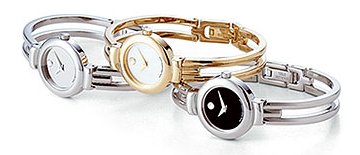|

Watch Components
Watch Parts
Watches contain many parts that work together to tell time, as well as
perform other useful functions. These could include a chronograph,
altimeter, alarm, day/date calendar, phases of the moon, slide-rule, etc. Here are descriptions of the major internal and external parts and their
functions.
Crystal
The cover over the watch face is called the crystal. There are three types
of crystals commonly found in watches: Acrylic crystal is an inexpensive
plastic that allows shallow scratches to be buffed out. Mineral crystal is
composed of several elements that are heat-treated to create an unusual
hardness that aids in resisting scratches. Sapphire crystal is the most
expensive and durable, approximately three times harder than mineral
crystals and 20 times harder than acrylic crystals. A non-reflective
coating on some sport styles prevents glare.
Hands
A watch's hands are the pointing device anchored at the center and circling
around the dial indicating hours, minutes, seconds and any other special
features of the watch. There are many different types of hands:
• Alpha: A hand that is slightly tapered
• Baton: A narrow hand sometimes referred to as a ‘stick hand’
• Dauphine: A wide, tapered hand with a facet at the center running the
length of the hand
• Skeleton: Cutout hands showing only the frame
• Luminous: Hand made of skeleton form with the opening filled with a
luminous material
Bezel
The surface ring on a watch that surrounds and holds the crystal in place
is called the bezel. A rotating ratchet bezel moves in some sport watches
as part of the timing device. If rotating bezels are bi-directional (able
to move clockwise or counter clockwise), they can assist in calculations
for elapsed times.
Crown
The nodule extending from the watchcase that is used to set the time, date,
etc. is called the crown. Most pull out to set the time. Many
water-resistant watches have crowns that screw down for a better
water-tight seal.
Dial
The watch face that contains the numerals, indices or surface design is
called the dial. While these parts are usually applied, some may be printed
on. Sub-dials are smaller dials set into the main face of the watch. These
can be used for added functions, such as elapsed times and dates.
Case (or Watchcase)
The watchcase is the metal housing that contains the internal parts of a
watch. Stainless steel is the most typical metal used, but titanium, gold,
silver and platinum are also used. Less expensive watches are usually made
of brass that has been plated with gold or silver.
Bracelet
A bracelet is the flexible metal band consisting of assembled links,
usually in the same style as the watch case. Detachable links are used to
change the length of the bracelet. Bracelets can be made of stainless
steel, sterling silver, gold, or a combination.
Strap
A strap is simply a watchband made of leather, plastic or fabric.
Internal Watch Parts
A watch’s main timekeeping mechanism is called its movement. Today’s watch
movements fall into two categories: Automatic mechanical or quartz.
Automatic mechanical movements mark the passage of time by a series of gear
mechanisms. Most automatic movements are wound by the normal, everyday
movement of your wrist, which charges the watch’s winding reserve. Quartz
movements are powered by a battery and do not stop working once removed
from your wrist.
Mainspring
The mainspring is the energy source responsible for powering the watch
movement (as opposed to a battery in a watch with a quartz crystal
movement). The spring is wound, either manually (using the winding stem) or
automatically, by the motion of the wearer’s wrist. Potential energy is
stored in the coiled spring, then released to the gear train which
transmits the power to the escapement and motion work, which turns the
hands on the watch dial.
Balance Wheel
The regulating organ of a watch with a mechanical movement that vibrates on
a spiral hairspring is called the balance wheel. Lengthening or shortening
the balance spring makes the balance wheel go faster or slower to advance
or retard the watch. The travel of the balance wheel from one extreme to
the other and back again is called oscillation.
Gear Train
This series of small gears in both quartz and mechanical movement watches
is responsible for transmitting the power from the battery (in a quartz
watch) or spring (in a mechanical watch) to the escapement, which
distributes the impulses that mark the time.
Escapement
This part of the watch restricts the electrical or mechanical impulses of
the gear train, metering out the passage of time into equal, regular parts.
Motion Work
The motion work is a series of parts inside a watch that receive power from
the escapement and gear train, which distribute and generate the watch’s
power. The motion work is responsible for actually turning the watch’s
hands.
Ashford Watches |
Breitling Watches |
Bulova Watches |
Casio Watches |
Citizen Watches |
DKNY Watches |
ESQ Watches |
Gucci Watches |
Invicta Watches |
IWC Watches |
Kenneth Cole Watches |
Luminox Watches |
Michele Watches |
Movado Watches |
Nike Watches |
Omega Watches |
Seiko Watches |
Skagen Watches |
Swiss Army Watches |
TAG Heuer Watches |
Tissot Watches
[ Home ]
|

